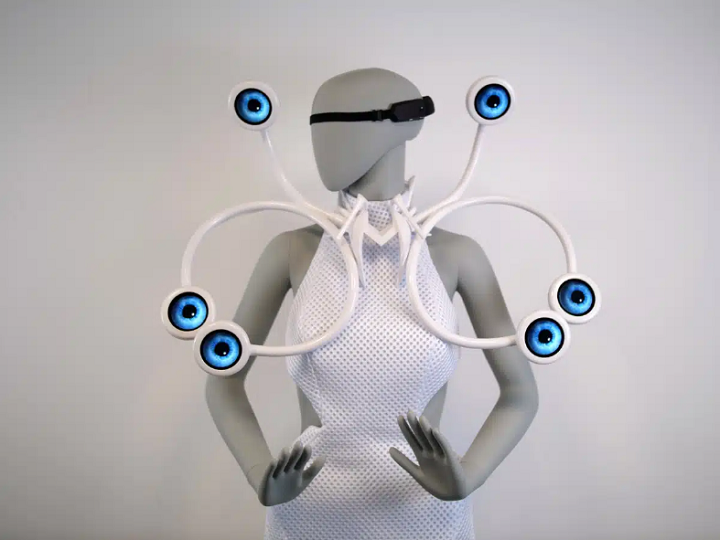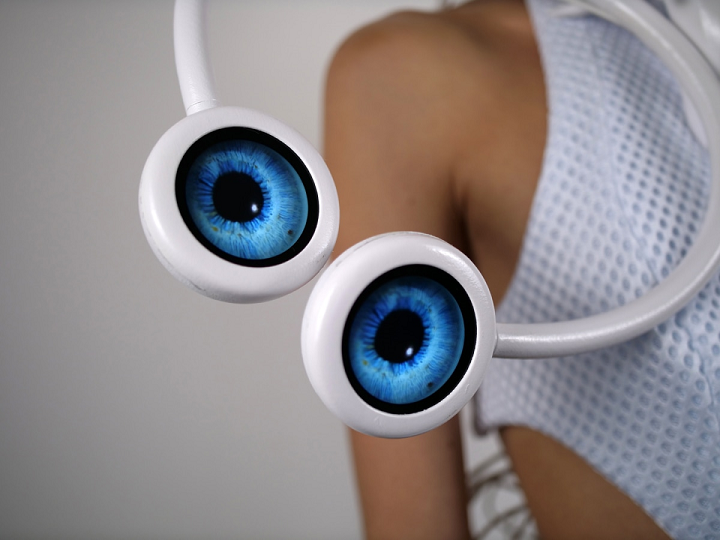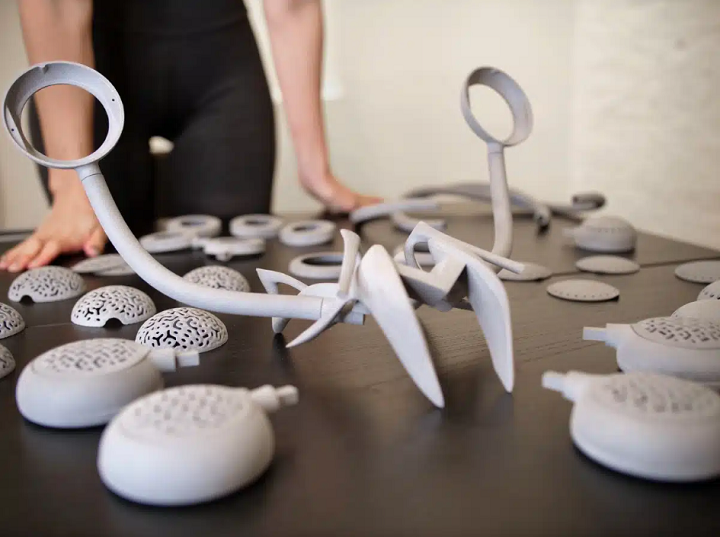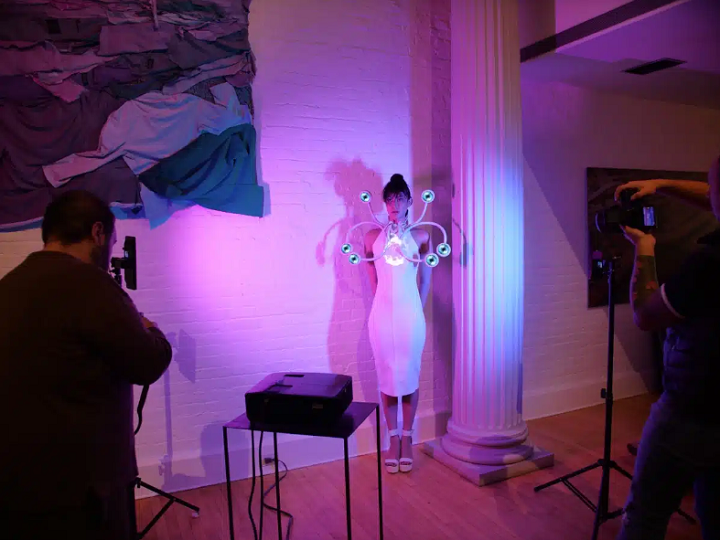Dutch FashionTech designer Anouk Wipprecht never fails to amaze. With a firm belief that fashion should have microcontrollers, her astonishing 3D printed dresses do everything from light up and attack to creating physical barriers. She’s also put her talents to work on BattleBots, prosthetics, costume pieces for Cirque Du Soleil, and more. Her latest project is just as impressive: a 3D printed, mind-controlled dress!
Her new ScreenDress, which features displays that respond through a brain-computer interface, was released earlier this month in Austria at the Ars Electronica Festival, Europe’s largest festival for art, technology and society. The dress is embedded with screens, which show how much stimulus your brain receives—basically, it measures the wearer’s cognitive load, which is how much information the working memory is able to process at any one time.
At any given time, I’ve got emails and social media notifications to check; friends, family, and telemarketers calling or texting; laundry and dishes to do, plus counters to wipe, floors to vacuum, and flower beds to weed; and four pets to take care of, including feeding them, playing with them, and cleaning up after them. I volunteer at church and community theatre, so I have tasks for those activities to keep track of as well. Sometimes I’m wiped out just thinking about all of it.
When your brain is overloaded like that on a daily basis, it can lead to fatigue, frustration, and stress, which can negatively affect your actions. But, as most normal humans, I try to keep that all on the inside so I seem like a capable adult, which sometimes means saying yes to things people ask me when I really don’t have the time, energy, or mental capacity to do them well. The ScreenDress might be able to help.
“The world is in the midst of a mental health crisis. We’re used to hiding our stress,” Wipprecht said. “But what if we could express the stress instead, and the rest of the world could adapt to our mental state?”
This concept dress offers a visual representation of the direct correlations between an action and how the brain reacts to it. It’s actually showing the world the wearer’s cognitive load by picking up subconscious signals from their brain and visually displaying them on the dress itself.
Wipprecht explained, “Fashion can help the wearer communicate with other people about what is going on inside their own bodies.”
A sculpted neckpiece on the ScreenDress has six round displays, each one resembling an eye with a pupil and an iris. The neckpiece is connected to a 3D printed 4-channel BCI headset, called the Unicorn Headband, which was developed by Wipprecht and neurotech company g.tec. This headband is an EEG sensor that forms a brain-computer interface, which tracks the person’s brain waves. Machine learning is used to determine the wearer’s mental load from the data collected, and this is visually reflected in real-time through the “eyes.” When the wearer is mentally overloaded, the pupils dilate wider and wider, and when they have a reasonable cognitive load, they constrict.
“With electronics becoming smaller and smaller, the possibilities became endless at the beginning of this century. What I have been trying to do for the past 20 years is to connect our bodies to electronics, robotic (fashion) design and wearable interfaces,” Wipprecht said. “However, what does it mean when we can connect technological-expressive garments to our bodies, body signals and even emotions? What dialogues can we trigger? This is what I am exploring with designs like these.”
So, how was this amazing garment created? Wipprecht designed the components for the ScreenDress in PTC’s Onshape cloud-native product design and development platform, using many of its design capabilities, like generative design, mixed modeling, rendering, and in-context design, to bring her vision to life.
“It helped me understand the look and feel of possible embedded LEDs and how light reflects back on the body and the space around it. It added more drama this way that we could investigate from the digital side before having to engineer it and explore it in real life.”
HP 3D printed the various pieces with its industrial Multi Jet Fusion 5420W system, which can produce engineering-grade white parts. Part of the HP Jet Fusion 5400 Series, its streamlined 3D printing workflow offers automated materials mixing, a natural cooling unit, and enclosed processing station. If Wipprecht had wanted a colorful dress, she could have used products from a company like DyeMansion to dye the neckpiece and its connected eyes. But instead she used HP’s new HR 3D PA12 W material, a type of nylon that also ensures quality, functional, and white parts. Wipprecht appreciated how lightweight the 3D printed parts were.
“The other cool thing about HP’s new PA12 W prints is that their white parts stay white and don’t discolor over time like some other prints I’ve worked with. They have outstanding shelf-life stability; I experienced no changes in color or mechanical properties after testing. The prints stay white consistently and have a nice light refraction and great strength.”
View this post on Instagram
The final piece of the puzzle is the machine learning software that powers the eyes on the dress. Each wearer goes through a two-minute training session when they first put on the dress, and the software then tunes to them to accurately estimate and represent their cognitive load. If I had the ScreenDress, maybe the next time someone asks me to do another task and can visually see my current stress level, they’ll ask someone else instead! That was Wipprecht’s whole idea behind the garment: fashion can help us navigate the various stresses of daily life.
Later this week, the ScreenDress will be presented during Brain Bar in Budapest from September 21-22, and then showcased during the Eindhoven Maker Faire from September 23-24.
Subscribe to Our Email Newsletter
Stay up-to-date on all the latest news from the 3D printing industry and receive information and offers from third party vendors.
You May Also Like
3D Printing Unpeeled: Biofuel Waste to Filament & Sustainable Photopolymers
I can’t ever remember a day with so many potentially high impact news stories have come out. In one story, we all know that there are problems with the safety...
Finnair Hires AM Craft to 3D Print Plastic Parts for Aircraft Interiors
Riga-based AM Craft, a supplier specialized in 3D printing aviation components and certified under EASA Part 21G, announced a significant achievement today. The company will assist in upgrading Finnair’s A320...
3DPOD Episode 198: High Speed Sintering with Neil Hopkinson, VP of AM at Stratasys
Neil Hopkinson, a pioneering 3D printing researcher, played a pivotal role in developing a body of research that is widely utilized today. He also invented High Speed Sintering (HSS), also...
3D Printing Webinar and Event Roundup: May 12, 2024
Webinars and events are picking up in the AM industry this week! ASTM International continues its Professional Certificate Course and Stratasys continues its advanced in-person trainings, while 3D Systems is...






































